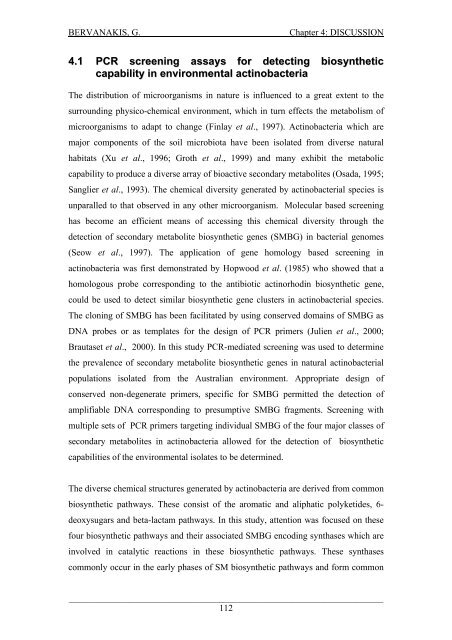Detection and Expression of Biosynthetic Genes in Actinobacteria ...
Detection and Expression of Biosynthetic Genes in Actinobacteria ...
Detection and Expression of Biosynthetic Genes in Actinobacteria ...
You also want an ePaper? Increase the reach of your titles
YUMPU automatically turns print PDFs into web optimized ePapers that Google loves.
BERVANAKIS, G.Chapter 4: DISCUSSION4.1 PCR screen<strong>in</strong>g assays for detect<strong>in</strong>g biosyntheticcapability <strong>in</strong> environmental act<strong>in</strong>obacteriaThe distribution <strong>of</strong> microorganisms <strong>in</strong> nature is <strong>in</strong>fluenced to a great extent to thesurround<strong>in</strong>g physico-chemical environment, which <strong>in</strong> turn effects the metabolism <strong>of</strong>microorganisms to adapt to change (F<strong>in</strong>lay et al., 1997). Act<strong>in</strong>obacteria which aremajor components <strong>of</strong> the soil microbiota have been isolated from diverse naturalhabitats (Xu et al., 1996; Groth et al., 1999) <strong>and</strong> many exhibit the metaboliccapability to produce a diverse array <strong>of</strong> bioactive secondary metabolites (Osada, 1995;Sanglier et al., 1993). The chemical diversity generated by act<strong>in</strong>obacterial species isunparalled to that observed <strong>in</strong> any other microorganism. Molecular based screen<strong>in</strong>ghas become an efficient means <strong>of</strong> access<strong>in</strong>g this chemical diversity through thedetection <strong>of</strong> secondary metabolite biosynthetic genes (SMBG) <strong>in</strong> bacterial genomes(Seow et al., 1997). The application <strong>of</strong> gene homology based screen<strong>in</strong>g <strong>in</strong>act<strong>in</strong>obacteria was first demonstrated by Hopwood et al. (1985) who showed that ahomologous probe correspond<strong>in</strong>g to the antibiotic act<strong>in</strong>orhod<strong>in</strong> biosynthetic gene,could be used to detect similar biosynthetic gene clusters <strong>in</strong> act<strong>in</strong>obacterial species.The clon<strong>in</strong>g <strong>of</strong> SMBG has been facilitated by us<strong>in</strong>g conserved doma<strong>in</strong>s <strong>of</strong> SMBG asDNA probes or as templates for the design <strong>of</strong> PCR primers (Julien et al., 2000;Brautaset et al., 2000). In this study PCR-mediated screen<strong>in</strong>g was used to determ<strong>in</strong>ethe prevalence <strong>of</strong> secondary metabolite biosynthetic genes <strong>in</strong> natural act<strong>in</strong>obacterialpopulations isolated from the Australian environment. Appropriate design <strong>of</strong>conserved non-degenerate primers, specific for SMBG permitted the detection <strong>of</strong>amplifiable DNA correspond<strong>in</strong>g to presumptive SMBG fragments. Screen<strong>in</strong>g withmultiple sets <strong>of</strong> PCR primers target<strong>in</strong>g <strong>in</strong>dividual SMBG <strong>of</strong> the four major classes <strong>of</strong>secondary metabolites <strong>in</strong> act<strong>in</strong>obacteria allowed for the detection <strong>of</strong> biosyntheticcapabilities <strong>of</strong> the environmental isolates to be determ<strong>in</strong>ed.The diverse chemical structures generated by act<strong>in</strong>obacteria are derived from commonbiosynthetic pathways. These consist <strong>of</strong> the aromatic <strong>and</strong> aliphatic polyketides, 6-deoxysugars <strong>and</strong> beta-lactam pathways. In this study, attention was focused on thesefour biosynthetic pathways <strong>and</strong> their associated SMBG encod<strong>in</strong>g synthases which are<strong>in</strong>volved <strong>in</strong> catalytic reactions <strong>in</strong> these biosynthetic pathways. These synthasescommonly occur <strong>in</strong> the early phases <strong>of</strong> SM biosynthetic pathways <strong>and</strong> form common_____________________________________________________________________112















